*from John Clare’s poem “Hares at Play.”
A couple of weeks ago our family—all three dogs in tow, one for each of us (our familiars in ways other than witchcraft)—headed south to a favorite lake. Despite that it was mid-May, the lake was still mostly a slurry of frozen surface shimmering in breaks of sun. Despite such reluctant ice, there was still a sense that the turn to spring was real. There were new calls of birdsong among the trees—warblers and varied thrushes announcing the season, despite little evidence of green life beginning to emerge.
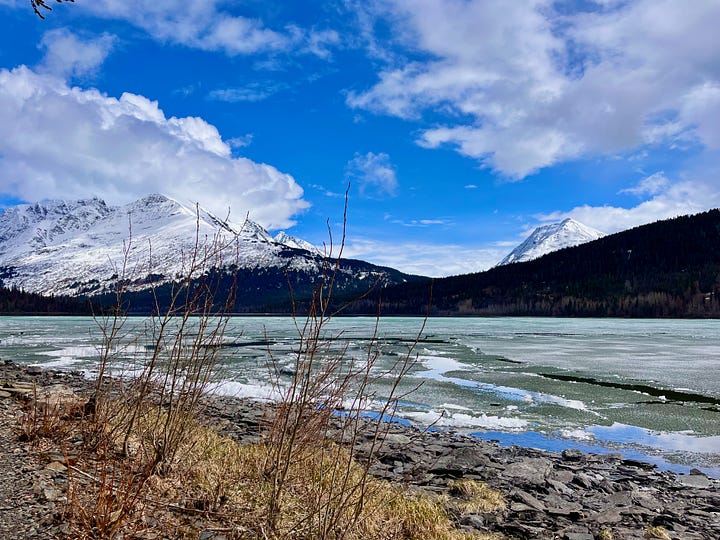
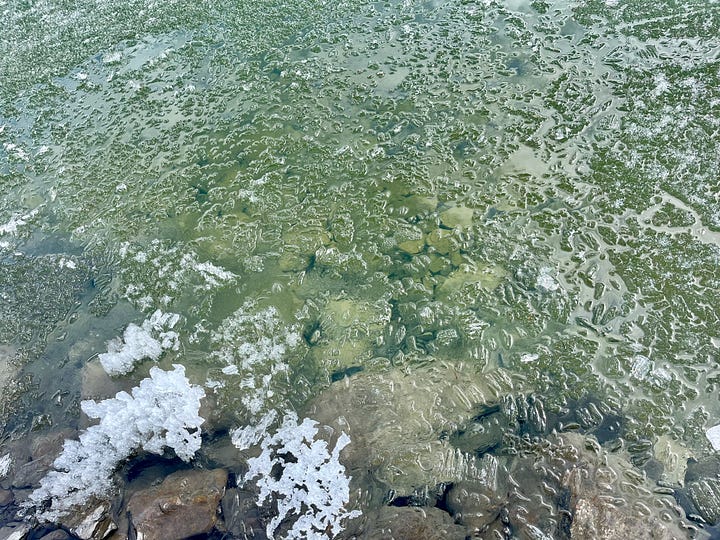

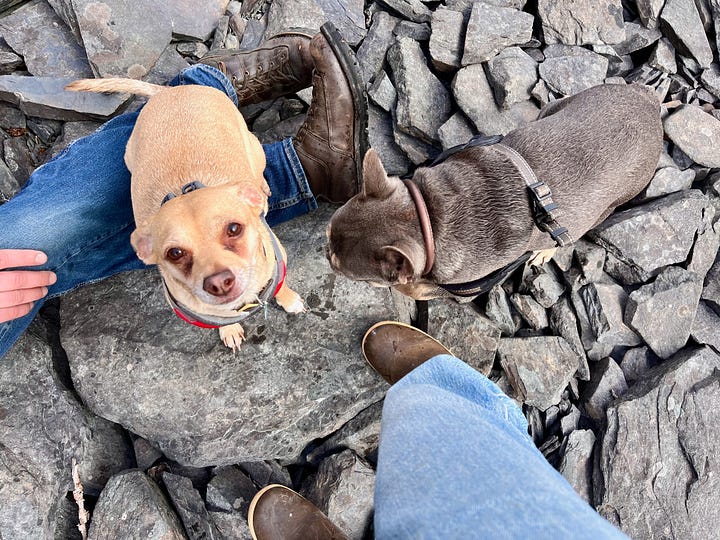
Still, we looked for small signs of plants stirring among the newly revealed remnants of last autumn—grasses brown and still matted, scatterings of leaf litter, recovering from the weight of long snow. As if the lands have to revisit where they left off before winter took hold, before they can fully awake to green and spring. We did find small drabas—so delicate and slight, blooming shyly among the rocks of a south-facing slope. And while looking at their small bloom, we also found, to our surprise, the hind leg of a snowshoe hare—doubtless the last autumn meal of a lynx before the snows of October settled in. It was preserved by the force of dry, cold months—lines of sinew and fur, all sort of strangely alive. The luck of finding a perfect, naturally occurring rabbit’s foot dawned on me, and not wanting to refuse such an offering, I pocketed it carefully to bring home.
Unlike rabbits, snowshoe hares turn snowy white as winter begins, with long hind feet and extra fur allowing them to spirit across fields of snow or broken tundra in equal measure. They also don’t burrow like rabbits, but find depressions in the ground to bear their young—who, also unlike rabbits, arrive from their mother’s body fully furred and clear-sighted, able to walk and run within a half-hour after birth. And, able to give birth to as many as four litters in one season, they have long been associated with fertility. Rabbits and hares share that ability—along with the ability to have multiple pregnancies from stored eggs, which caused some to believe they were hermaphrodites, or androgynous—or a sign of virgin birth, which is why medieval and renaissance paintings often show Mary with a rabbit at her feet.
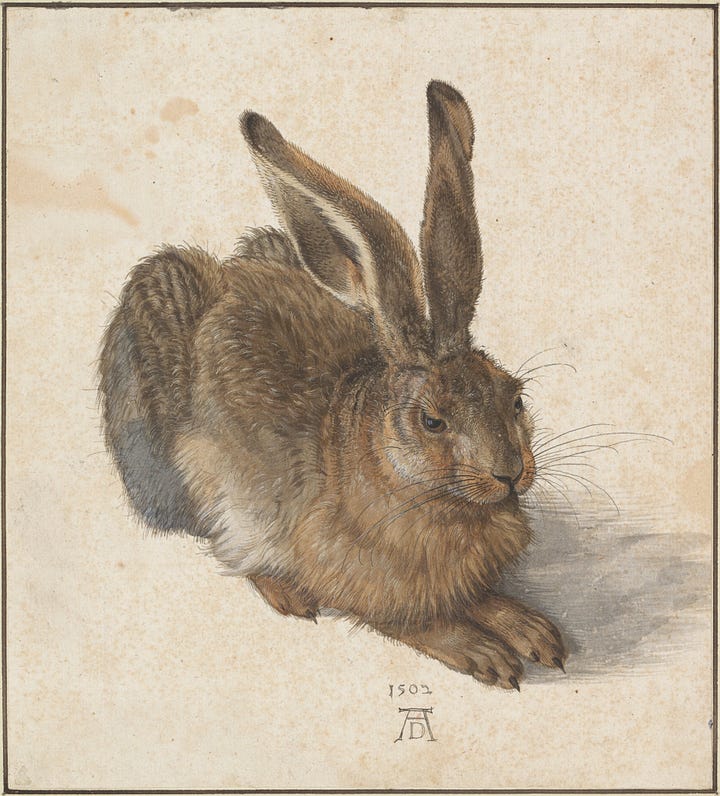
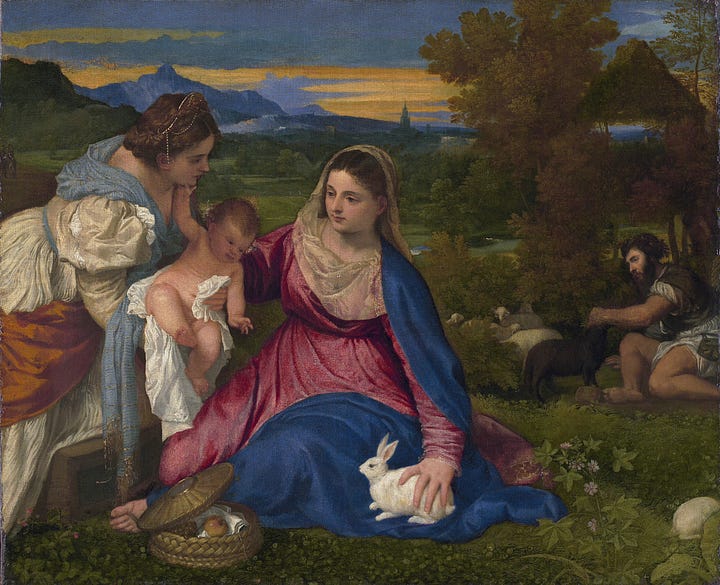
So it’s little wonder that this is all part of why we have hares and rabbits associated with Easter and spring, with the turn of the earth towards a warmer time when plants are reborn. Easter is thought to derive from the name for the Anglo-Saxon goddess Eostre, who could take the shape of a hare, and who was also associated with the dawn and the rising sun—which is also echoed in the word east.
But there’s another aspect—or a similar tie—to the roots of eoster, ester, estre. It’s also a part of an Old English suffix -estre, which denoted a woman worker or specialist. So a word like semestre, is an earlier form of seamstress,1 and tæpestre, for example, denotes a woman who taps or pours the beer from a barrel. For a male worker, the suffix was -ere. So, as Jenni Nuttal writes in her book Mothertongue:
Your daily bread could be made by a bæcestre or a bæcere, the feminine or masculine suffix signalling whether the baker in question was a woman or a man.2
Because of this gendered distinction, historians can identify some of the work of women inside and outside the home in medieval England by these suffixes.
Later, -estre shifted into -ster, and the female suffix became the default for a worker of any gender. And so words like tapster became the general term for whoever served your drink, and the same for a webster (someone who weaves), a maltster (someone who makes malt), a combster (someone who prepares wool), or a hewster (someone who dyes fabric).3
All of these threads of language, labor, pulled apart, point to a more androgynous reckoning of work, craft, and mastery than what we are so often told are proscribed roles for men and women—or, as some footballer speech would have it—their true vocation. (Because, ugh, of course).
There’s another part of Anglo-Saxon etymology that also had me thinking through whether or not I should have left the hare foot where it was, to become part of the earth in the place where it presumably died, if it is pure hubris to think I can honor such an unusual offering by taking it home and caring for it among my other treasures from walks—a small paper wasp nest; a fragment of a robin’s egg; the errant feather that was left behind after a quick ascent. Is it nature still if I take it away from ‘nature’?
Which would be a strange question to a medieval Anglo-Saxon, because there was no word, and thus no concept, of ‘nature’ in medieval Old English. As Hana Videen writes in Deorhord,
In the world of Old English there is no ‘creature’ and no ‘nature’; instead we have sceaft (creation). Sceaft includes everything in the world…humans, animals, plants, rocks and the sun, even dragons, phoenixes and other fantastical creatures.4
All that has been and ever will be is sceaft—animal, tree, mountain, river, people. No separation of humans from ‘nature,’ no separate names to parcel into hierarchies of rank, sentience, consciousness, ‘personhood.’ And because people are part of sceaft, they looked around them to understand how to live, learning about themselves from the other inhabitants of sceaft.
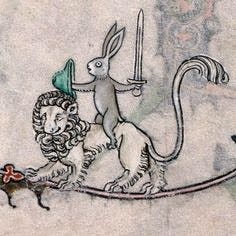
Last week I read an article on the way that people are not the only inhabitants of this world to self-medicate with plants. Animals have done this as well, and is likely the way that humanity learned about plant lore—of what is edible and what is not, and specific plants to treat certain symptoms. Much of it learned by observing and living alongside animals.
I was fascinated, as I’ve long wondered about how we learn to eat and prepare the foods we eat, the poisons that become known. How and when and where cultures learned the very fine distinctions, in many cases, between what can nourish and what can harm, but also what can heal. It makes so much sense—because of course if you watch an animal eat something you might think that you too could use it for the same purpose. Especially if you aren’t conditioned to think that humans are somehow separate from the rest of the world.
It made me think of what else we take for granted and assume is unique to people—to ‘culture,’ that other entity that separates us from ‘nature.’ What more we must have gained from knowing and caring about the fellow inhabitants of sceaft: to learn of traps, nets, and weaving from spiders; to learn of wings from birds and insects and dream of flight; armor from insects with the strength of their exoskeletons; hoses from elephants and mammoths; ladders from giraffes; hermit cells from the swallow, bee; preparation for winter from the trees who lose their tender leaves to stand only with the bark to endure the cold dark months; spears from the tusks of elephant, mammoth, and boar; quills from porcupines; swimming and holding our breath from sea mammals; diving from puffins, auks; boats with rudders and keels from the submerged feet of loons and waterfowl; insulation from chickadees, puffing their feathers in the cold months; caching and storing food from squirrels; trails that became roads from the tracks of animals finding a path of least resistance across distances; writing from animal tracks in sand, mud, and snow; how to hunt from the wolf, lion. How to be silent from the owl; dams from beavers; dens from bears; song from the robin, warbler; things not always as they seem from the flashing iridescence of a magpie’s tail. Camouflage from the moth, ptarmigan, and snowshoe hare.
I remembered while writing the above that I was given a rabbit’s foot when I was a kid—from whom I can’t remember, but I do remember being entranced at the idea of it giving luck. I believed it with the fervent belief of a six-year-old, knowing I had a secret I could keep with me. It felt protective, friendly—I thought my care and attention to it might also serve me with a similar care. As I grew up a bit I was convinced of some things being lucky—a necklace charm, a favorite stone—and know it probably goes back to that artificial rabbit foot I believed was real, of how it allayed the feelings of fear in the dark, shyness around others. That I could be quiet, still—or clumsy—because of that secret between me and a rabbit whose foot was given to me for protection. I had some luck on my side.
As I sit with the snowshoe hare foot on my desk, I wonder if that is what the gift of such finds is—that they become what we need to feel just a bit more magic, a bit more of a feeling of sceaft, of being an inhabitant of the world with other inhabitants, all trying to live and make the best of what is far too often a scary, awkward, noisy world. The luck of finding something that causes you to pause and be curious, to feel protected and protective of the unexpected. To find that through an unexpected offering, you can be reminded of how Eostre became -estre became -ster, and how the name of an older god lives inside women’s bodies and labor, but also that the feminine stands for all bodies as much as we are told masculine terms do. That we are all sceaft.
The hare’s foot has flecks of brown mottled fur along with the white fur they were becoming—a sign of their passing being in the autumn, large enough to be an adult that perhaps lived more than one trip around the sun. Part of the fertility of rabbits and hares is their ill luck at being easy prey. Many rarely live longer than a year. Or perhaps it is the luck they offer others to ensure that there is ample food to sustain other beings of sceaft. Not separate, all inhabitants of the same world.
The pads of the hare’s foot are full of dense white fur, and with long hind legs distributing their weight, you can see how they would be able to float on the snow and not betray its cold. Not unlike the boots we wear to keep our feet warm enough to be out in winter, and the snowshoes we wear to not sink so quickly into heavy snow. Maybe they are called snowshoe hares because of what we learned from them, not what we’ve ascribed to their bodies.
Maybe they taught us how to keep warm, change with the seasons, and with a little luck, make a way in this life so that we too might see the world turn into another spring.
on the way back we found the terns had arrived, that you can see in the above if you squint a bit….
-ess, denoting a woman such as in seamstress, poetess, would arise after the Norman conquest in the 11th century, when French terms were adapted into English. Oddly seamstress is a mashup of the words of the labor—joining seams—with the addition first of -estre, which morphed into the general term -ster, and then the French -ess, to get to seamstress—as in first a woman seam worker, than a general seam worker, then a general but female seam worker. O English, you messy mixed-up language…
Nuttall, Jenni. 2023. Mothertongue: The Surprising History of Women’s Words. Virago Press. p. 164-5
Ibid.
Videen, Hana. 2024. Deorhord: An Old English Bestiary. Princeton University Press. p. 9





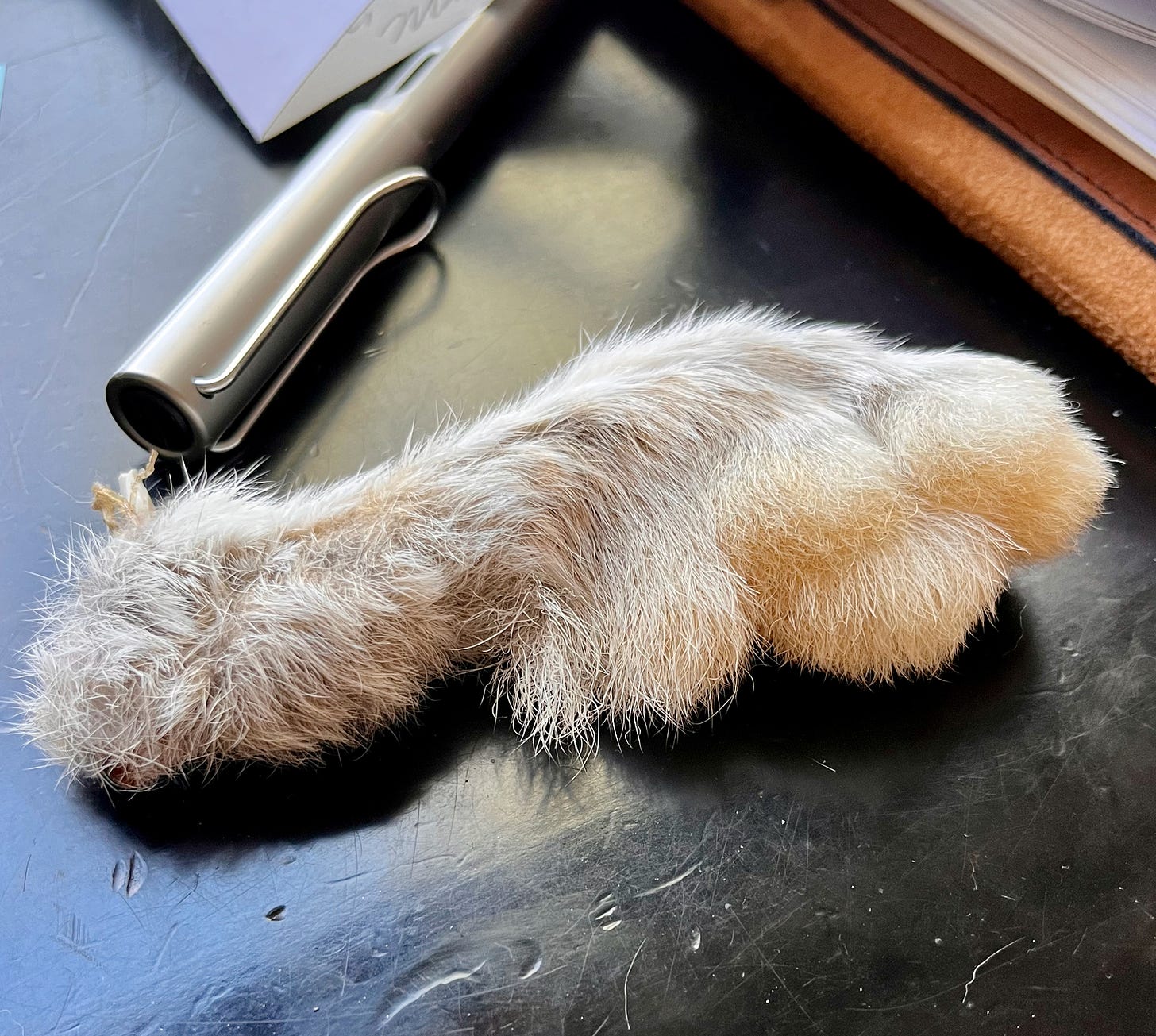





This was fascinating, Freya. I loved the paragraph listing all the things we have learned from nature. Did sceaft become scape, as in landscape? And perhaps share a root with schaft in German?
What an absolute joy to read and see! Beautifully written on so many levels.
My second degree was in linguistics and even though I had to abandon my MA in comparative Indo-European linguistics for health reasons and concentrate on archaeology only, seeing someone deal with IE etymologies will always make my heart beat a little faster. (I tried to compensate for my loss a bit by writing a thesis on IE archaeology, ha!)
Just yesterday I was questioning myself why do I fill every windowsill in the house with beachcombed offerings. Why can't I just "organise" it and hoard it all in my studio? At first glance it seems like sloppiness, but I'd say my mind doesn't want to sort them out. It wants to keep small bits of nature and heritage everywhere to break the sterile nature of our contemporary dwellings and remind me of our place within sceaft.